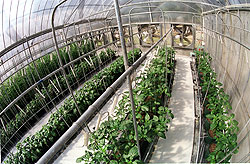STATE OF THE AGRICULTURE INDUSTRY
 Agriculture in Hong Kong is undertaken mostly in the urban fringes. Currently, only 19 square kilometres of the territory’s total 1 104 square-kilometre land area are farmed. About 5 300 farmers are engaged in agriculture. Agriculture in Hong Kong is undertaken mostly in the urban fringes. Currently, only 19 square kilometres of the territory’s total 1 104 square-kilometre land area are farmed. About 5 300 farmers are engaged in agriculture.
The local agricultural industry involves producing quality fresh food through intensive land use and modern farming practices. Despite its relatively small size, the industry produces a substantial amount of vegetables, poultry and pigs for daily fresh food consumption. Local agricultural production in the years 2004 and 2005 was valued at about $1.12 and $1.18 billion respectively. Statistics on agricultural production, fresh foodstuff consumption and agricultural land utilisation are shown in the Appendices 1 to 3.
 Vegetable crops grown year-round include Chinese white cabbage, flowering Chinese cabbage, lettuce and celtuce. Long bean, water spinach, Chinese spinach, cucumber and several species of Chinese gourd are produced in summer, while spinach, watercress, Chinese kale and matrimony vine are grown in the cooler months. Vegetable crops grown year-round include Chinese white cabbage, flowering Chinese cabbage, lettuce and celtuce. Long bean, water spinach, Chinese spinach, cucumber and several species of Chinese gourd are produced in summer, while spinach, watercress, Chinese kale and matrimony vine are grown in the cooler months.
Flower cultivation has gained importance in recent years. Orchids and ornamental plants are now grown all year round. Dahlia, chrysanthemum, lily and gladiolus are grown in winter, while ginger lily, lotus flower and sunflower are grown in summer. Peach blossom is also grown for the Lunar New Year season.
 PREMIUM VEGETABLES PREMIUM VEGETABLES
The Department continues to promote the cultivation of premium vegetables to serve niche markets and help farmers gain better economic returns. A variety of water melon with yellow flesh was introduced to farmers for production in summer. Two cool-season varieties of vegetable, Hok Tau Pak Choi and mid-flowering Chinese kale, were also introduced to help farmers achieve year-round, high value production.
 AGRICULTURAL STRUCTURES AGRICULTURAL STRUCTURES
Greenhouses
Controlled-environment greenhouses are built with transparent plastic film or polycarbonate sheets to provide an enclosed environment that enables the artificial regulation of temperature, humidity and intensity of light for the optimal production of crops. Advanced greenhouses are often also equipped with automatic irrigation, fertilisation and/or spraying systems to further increase productivity.
 |
The Department has adapted greenhouse technology to local conditions and extended it through seminars and demonstrations to farmers for the intensive production of high value crops such as white bitter cucumbers, rock melons, edible fungi and lilies. Newsletters are published regularly to keep farmers updated with the latest developments and an electronic version is also available on the Department’s website.
|
|
Letters of Approval
Under the terms and conditions of land grants, a farmer who wishes to build an agricultural structure (greenhouses, livestock sheds, hatcheries, fish ponds or store rooms) on leasehold agricultural land must apply to the Lands Department for a Letter of Approval for Agricultural Structures. To facilitate applications by farmers, the AFCD has streamlined procedures with the Lands Department and taken up the responsibility for assessing such applications. During 2005-06, the Department processed 14 applications covering 70 agricultural structures. Some 19 greenhouses and 33 other structures were also granted appropriate approval from the Lands Department.
SUPPORT AND ASSISTANCE
 Agricultural Support Services Agricultural Support Services
The Department promotes the return of fallow land not earmarked for development to cultivation by helping farmers arrange land tenancy, improving soil conditions, and providing marketing facilities and farm road access. During 2005-06, 3.46 hectares of such rehabilitated agricultural land were serviced. The Department responded to 5 384 technical inquiries related to agricultural production or development and conducted 279 field investigations in connection with irrigation and other agricultural matters.
Agricultural Credit
The Department operates the Kadoorie Agricultural Aid Loan Fund, the J.E. Joseph Trust Fund and the Vegetable Marketing Organisation Loan Fund to meet farmers’ credit needs. A total of $21.93 million was lent to farmers during 2005-06, including 72 loans totalling $3.935 million to crop farmers; 153 loans ($12.919 million) to livestock farmers; 17 loans ($1.275 million) to pond fish farmers; 33 loans ($3.26 million) to mariculturalists and four loans ($0.54 million) to agricultural co-operative societies.
Emergency Relief Operations
Emergency relief grants are issued to needy farmers who suffer from natural disasters. Grants totalling $3.7 million were distributed to 1 214 farmers during 2005-06.
FRESH FOOD WHOLESALE MARKETS
 The Department manages four government-built wholesale food markets providing some 2 600 trading stalls and related ancillary facilities. Together these markets provide some 40% of the fresh food commodities (vegetables, freshwater fish, eggs, fruits and live poultry) consumed by the community. Appendix 15 gives details of the market throughput in these wholesale markets. The Department manages four government-built wholesale food markets providing some 2 600 trading stalls and related ancillary facilities. Together these markets provide some 40% of the fresh food commodities (vegetables, freshwater fish, eggs, fruits and live poultry) consumed by the community. Appendix 15 gives details of the market throughput in these wholesale markets.
In managing these markets, the Department is committed to saving costs through productivity improvement and streamlining, and passing these savings to market tenants as rent reductions. As a result, rent for the two largest market complexes was reduced by 9.4% from 2004-05 to 2005-06. During the year, additional service contracts were tendered to improve the conditions at refuse collection points and associated facilities.
|
|